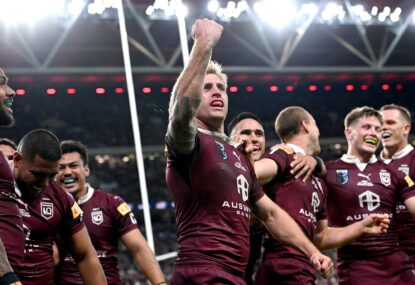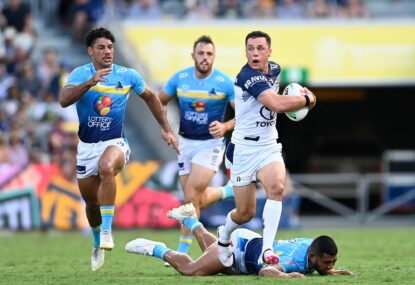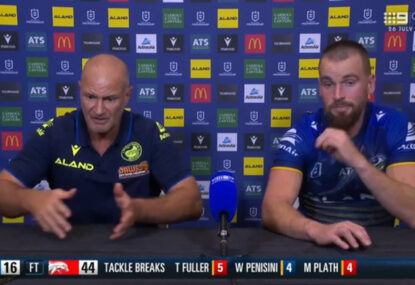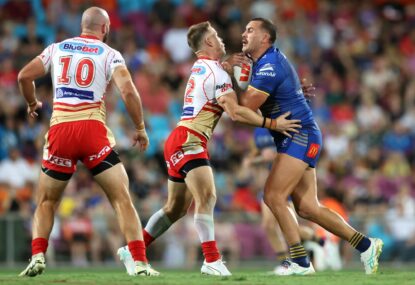Beau Scott’s signing with the Knights seems to have opened a can of worms regarding the transfer of players between clubs (as invariably happens each season), to the point where the old draft discussion has been dusted off and brought out to see the light of day again.
For starters, I don’t think it’s actually that big a deal.
This season we’ve had Scott and Dave Taylor announce they’re moving on next year. Given that we’ve got 16 teams with 25 players each (not including tier two or Toyota Cup players), should we be hitting the panic button based on two of well over 400 hundred players?
As a Bulldogs fan I experienced this situation first hand with the “cashed-up” Titans signing Jamal Idris early last season. While it was disappointing it certainly didn’t affect my enjoyment of the game, my team or the player.
I don’t know how the draft solves this problem. From what I understand, it doesn’t.
The other problem the draft is supposed to solve is the even distribution of talent between clubs.
We have arguably the most even premier sporting competition in the world with nine different premiers over the past 11 years. We’ve also had the Warriors, Eels and Cowboys play in grand finals over that period.
All the pre-season hype was that this was going to be the closest season on record.
The on-field action supports this to the point where on Monday night we saw a team winless in 2012 (and who had lost their previous ten games) beat the undefeated, top-of-the-table reigning premiers. Can it get much more even?
Cameron Smith suggested recently that the NRL was a laughing stock for not having a draft.
I don’t see how the NRL has anything to learn in terms of talent distribution from the AFL who typically have a top four miles ahead of the rest, a middle eight battling away for the remaining semi spots and three or four clubs at the bottom of the table that struggle to win a game except against each other.
The AFL should be looking to league on how to distribute talent evenly between teams and create an even competition.
If these early season signings need to be stopped, I’d suggest that clubs, players and agents be banned from making announcements on signing players except for a two week mid-season window and then post season.
Negotiations should be free to continue at any time.
The reason for this is that the old June 30 deadline never worked and was completely unenforceable. Allowing clubs to negotiate but banning announcements is far easier to police and monitor compliance.
Yes there will be speculation about who might be going where, but that happens all the time anyway (Sonny-Bill, Foran, Minichiello et al) and isn’t necessarily a bad thing.
The other thing I’d implement would be salary cap concessions for players who have played extended periods for one club.
We have to move away from the concept of ‘local juniors’.
The original boundaries in Sydney were divvied up in 1908 and are no longer valid because of the super-juniors areas like Parramatta and Penrith, not to mention one city/region/country teams like Brisbane, Newcastle, New Zealand or North Queensland or the junior-less Melbourne and potentially Perth.
The salary cap concession method I would prefer to see in place is based on when a player is first signed to a club and joins that team’s system, rather than when a player makes his NRL debut.
Local juniors would obviously make up a large part of this talent pool for the Parramattas, Brisbanes, etc.
The player would then start accumulating salary cap concessions based on the number of years he is within a club’s system regardless of whether or not he actually goes on to play at NRL level.
Being a Bulldogs fan I call this the Asotasi Effect as I like to use Big Roy as an illustration.
Roy wasn’t a local junior but started with the Dogs at age 16 when he was scouted and signed by them.
He was put up in Sydney with club supporters and played for the Dogs junior sides for years before becoming an NRL player. The Dogs put a lot of time and money into identifying, nurturing and developing Asotasi’s talent long before he got anywhere near the NRL.
Fast forward eight years and he was regarded as one of the best props in the world. The Dogs were getting some return on their investment.
Then Souths swoop in and offer $400k+ per season to sign him which the Dogs simply couldn’t compete with. They received nothing in compensation for the time, effort and money it took to develop Asotasi.
Why would clubs bother putting time into juniors and developing players when the situation above can happen?
I’m not bagging Souths at all because all teams do it (including the Dogs – more than I’d like recently).
In my system, Asotasi starts accumulating salary cap concessions from the year he joins the club or from his 16th birthday, whichever is the latter. Say at 2% per year (the numbers are not definitive).
The concession doesn’t kick in until he is part of the top 25 contracted players and it can only be applied to Asotasi. After eight years in the Bulldogs system he is entitled to a 16% concession.
If a rival club comes in to offer a contract, the Bulldogs can make a counter offer, 16% of which is not included under the salary cap.
Players will still change clubs – it’s likely that Asotasi would have moved anyway even if the concession system above was in place. The salary cap will still ensure even distribution of talent.
This system will, however, reduce the number of players forced to switch clubs or head overseas and increase the likelihood of one club players. It will also reward clubs that put the time, effort and dollars towards identifying and developing talent from a young age.




































































































